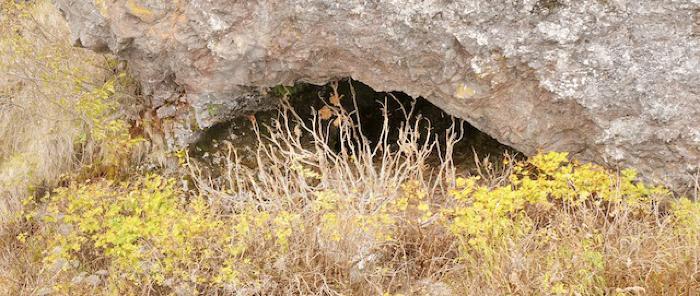Cave — Legtaq, Qaiqunaq (old form)

Caves are natural shelters that attract both people and animals. Archaeological data from Prince William Sound illustrate that the prehistoric Alutiiq people camped in caves. Although similar settlements are poorly known from the Kodiak region, oral histories and historical accounts indicate that caves were religious sites: whaling shrines. In these secret places, the spiritually potent men who killed giant sea mammals secluded themselves from daily life to prepare for the hunt.
Like the position of whaler, caves were inherited, passed down through elite families. Each successive owner added to his cave’s contents. Particularly prized were mummified corpses. Whalers stole the physical remains of powerful people, which they mummified and stored in their caves with other talismans: eagle feathers, bear’s hair, green stones, and berries. They also kept hunting gear, whaling poisons, and special clothing in these private locations.
French anthropologist Alphonse Pinart, who visited Kodiak in 1872, provides an account of the contents of a whaler’s cave. This cave had mummies seated behind curtains of sea lion skin. Each mummy, male and female, was positioned as if it were producing tools: grinding slate spears, carving arrow shafts, or sewing gut. With these mummies, the whaler symbolically enlisted the help of a powerful ancestor to produce his tools. In return, he fed them pieces of sea-mammal meat. The center of the cave featured a small pond with a model boat. In the boat sat a replica of a man holding a whaling spear aimed at a model whale. With these miniatures, the whaler enacted the hunt. Other activities that took place in and around whaling caves included processing human corpses to make mummies and producing whaling poison from human fat and the roots of the monkshood plant.
All of these activities perpetuated life by providing food. Alutiiq people believe that animals choose to give themselves to people. A well-prepared whaler who demonstrates reverence for an animal’s spirit will be successful. In preparation, whalers called upon the power of previous generations. Mummies represented people who had succeeded in life, who had maintained a proper spiritual balance. The use of their corporeal remains in whaling poisons imbued the hunter with their power. Life, therefore, depended on careful action, proper spiritual alignment, and a reverence for the past. These same elements are evident in Alutiiq winter festivals, the major annual religious ceremonies.
